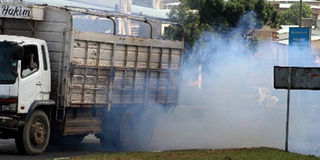Cities across Africa groaning under the burden of cancer-causing air pollution

A lorry spews exhaust fumes into the road in Nairobi. PHOTO|FILE
What you need to know:
- Particulate matter is a major component of outdoor air pollution and is widely used as a health relevant indicator of air quality. Fine particles, usually referred to as PM2.5 are a major concern.
- Urban centres are likely to combine higher concentrations of atmospheric pollutants and an increase in the number of exposed people.
Last October, the International Agency on Cancer Research, an affiliate of the World Health Organisation, classified outdoor air pollution and particulate matter as carcinogenic to humans.
Although the adverse effects of air pollution on human health have long been recognised, this new development is noteworthy.
Most people already know that exposure to tobacco smoke is a major risk factor for lung cancer, but they may not understand why “dirty air” falls in the same category.
After reviewing the latest scientific literature, the agency’s panel of experts found sufficient evidence that exposure to outdoor air pollution is carcinogenic.
According to a recent article in the journal, Nature Reviews by researchers from the University of Sao Paulo, Brazil, there is a strong association between lung cancer and prolonged exposure to air pollution, especially particulate matter.
PREMATURE DEATH
In fact the risk of lung cancer rises with increasing exposure to higher levels of particulate matter.
Particulate matter is a major component of outdoor air pollution and is widely used as a health relevant indicator of air quality. Fine particles, usually referred to as PM2.5 are a major concern.
Atmospheric particles are classified according to their size from 0.005 micron (m) to 100 m in diameter.
PM2.5 refers to particles with an aerodynamic diameter less than 2.5 m. The diameter of the average human hair is 70 m, which is about 30 times bigger than the largest fine particle.
Particles come in many sizes and shapes and can be made up of different types of chemicals. The smaller the particle, the more likely it is to penetrate deep into a person’s respiratory system, or get absorbed directly into the bloodstream.
By 2050, exposure to outdoor air pollution is expected to become the top environmental cause of premature death globally.
This is more likely to be observed in developing countries where there is increasing industrialisation and growth of urban areas combined with a lack of air quality standards.
While many developed countries in North America and Europe have air monitoring programmes, quality guidelines, and legislation aimed at mitigating pollution, this is not the case in many African countries.
Yet Africa has the fastest growing population in the world, and by 2050, it is estimated that 60 per cent of Africans will be living in cities. Urban centres are likely to combine higher concentrations of atmospheric pollutants and an increase in the number of exposed people.
Although few studies have examined the levels of particulate matter in urban areas across the continent, data indicates there should be cause for concern. In Nairobi, teams of students and researchers from New York City’s Columbia University, the University of Nairobi and Jomo Kenyatta University of Agriculture and Technology carried out a study on PM2.5 emissions from motor vehicles in July 2009.
MONITORING PROGRAMMES ESSENTIAL
By sampling along busy roads, namely River Road, Ronald Ngala, Tom Mboya and Thika Road, as well as in an open field, they sought to compare levels in high traffic areas and the outskirts of the city. The average levels reported in the journal, Environmental Research and Policy, range from 58-98 g/m3 at the four sites in the city.
Past studies of PM2.5 in other cities such as Cairo, Egypt showed average annual levels of 85 g/m3 while in Accra, Ghana the range is from 30-70 g/m3. A study in Qalabotjha, Free State in South Africa, recorded levels between 71-93 g/m3.
Current WHO guidelines for PM2.5 are an average of 25 g/m3 for exposure over 24 hours, whereas the annual mean is 10 g/m3.
Because the sampling in Nairobi was done over 12 hours, it is difficult to make a direct comparison to the WHO guidelines. Still, from these examples, it is evident that particulate matter levels in African cities often exceed international guidelines.
Establishing atmospheric monitoring programmes is an essential step in tracking air pollution over a long period of time. Such information would be invaluable in formulating policies to reduce emissions and in monitoring impacts on human health.
Dr Warau is an environmental scientist. ([email protected])




